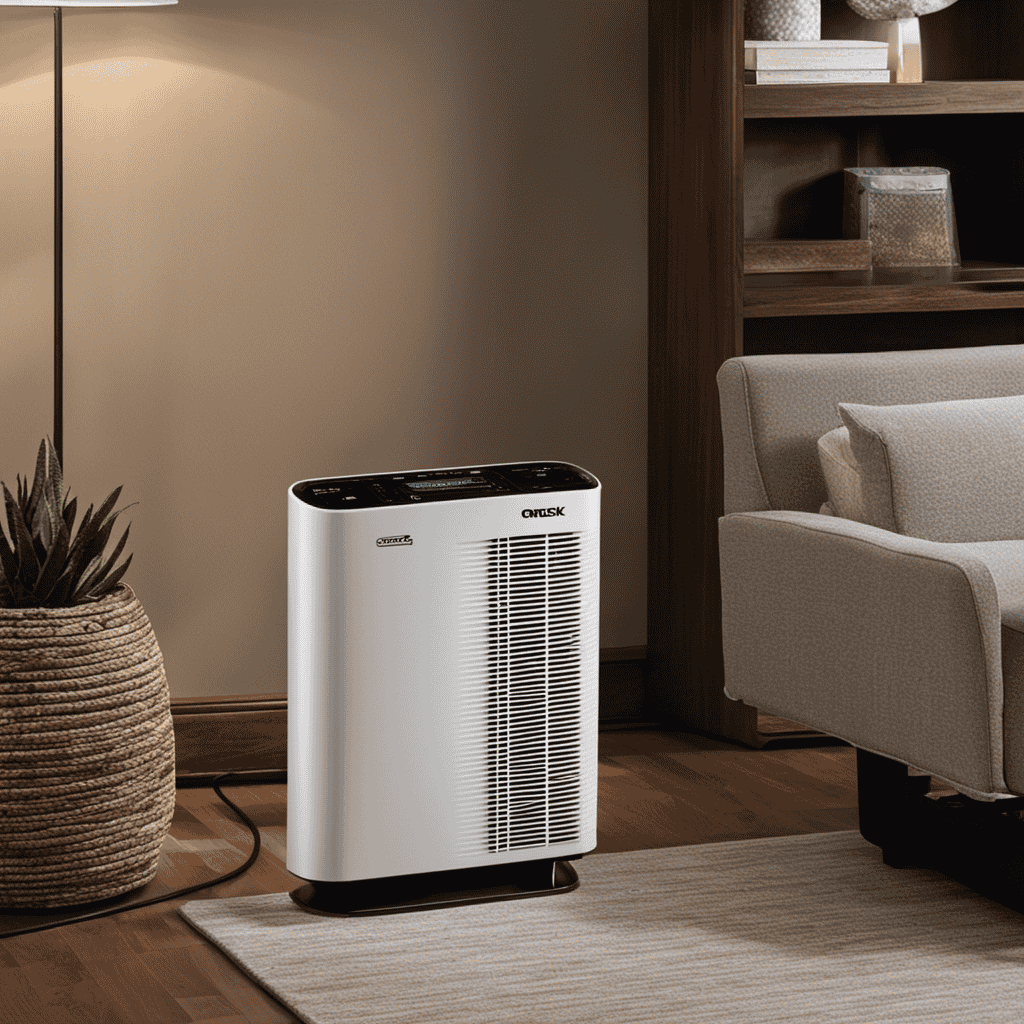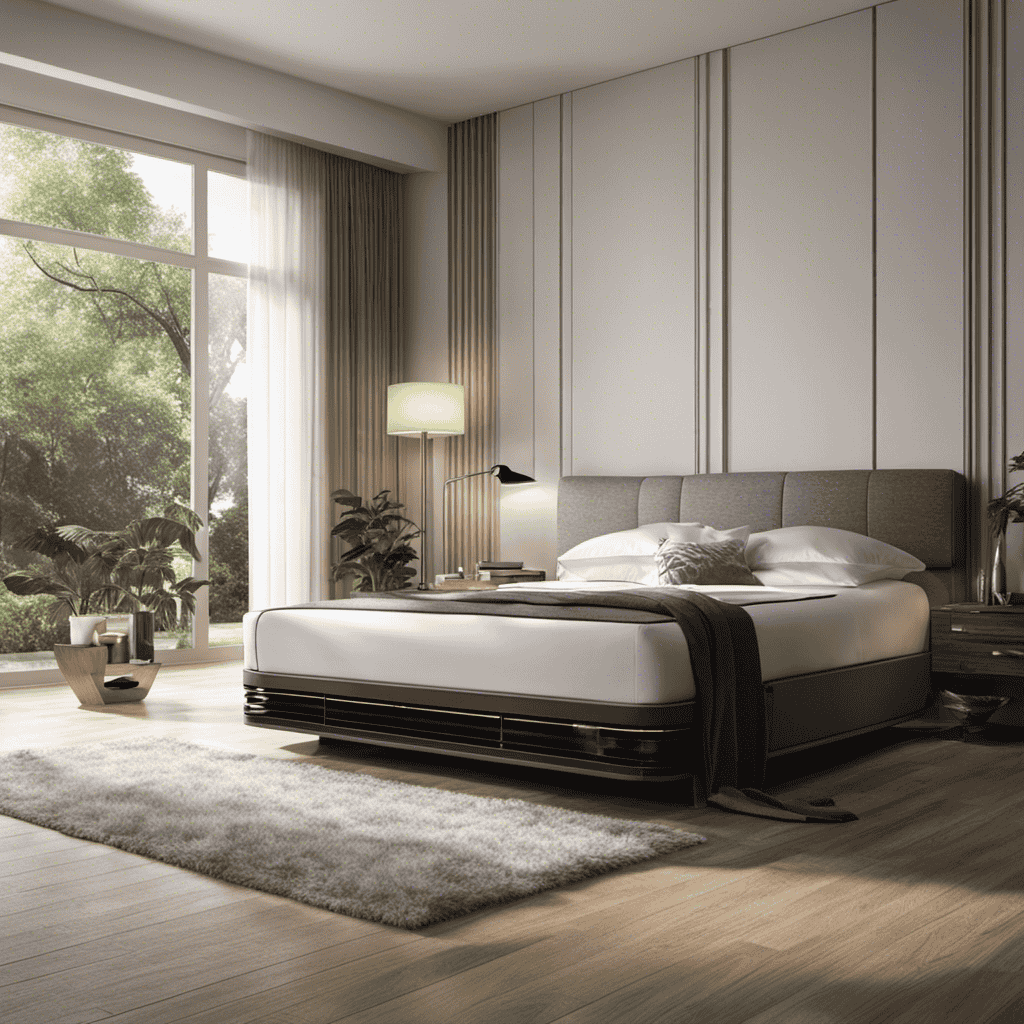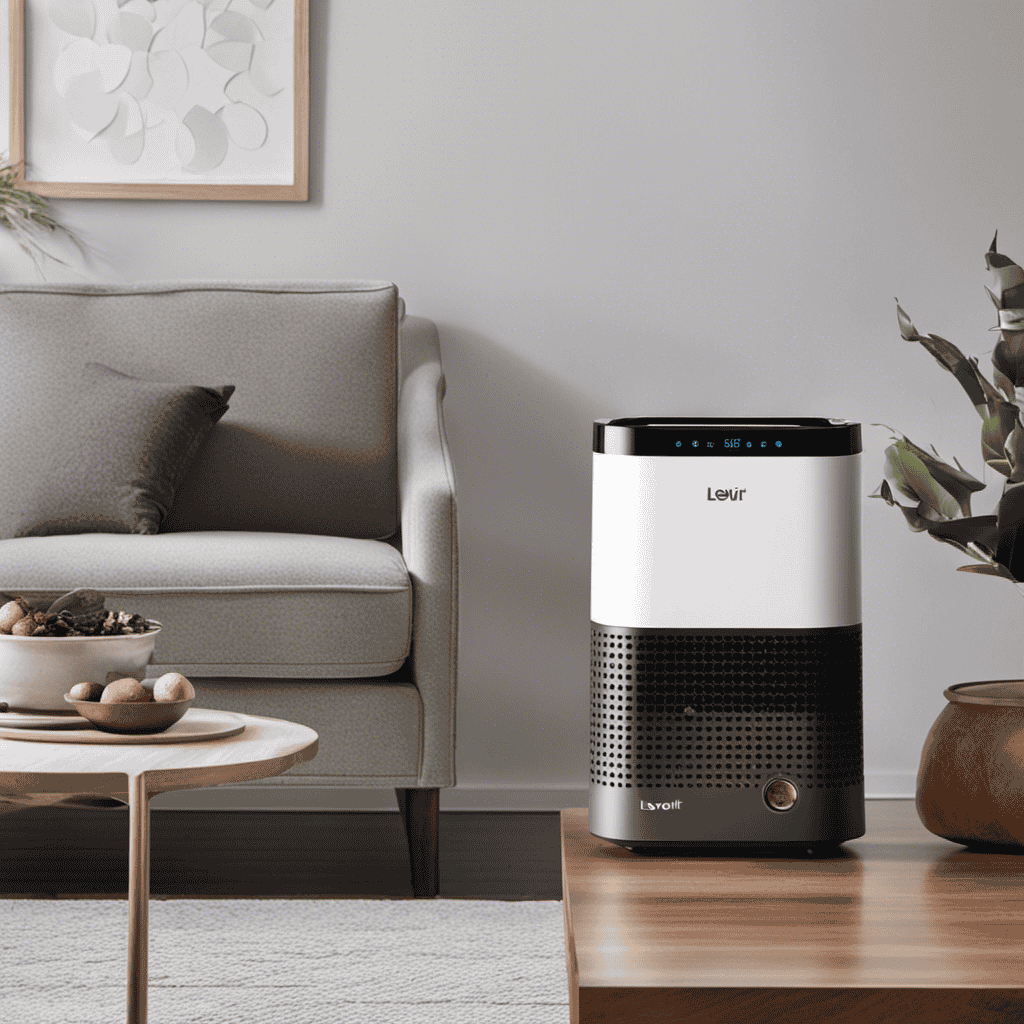As someone who is passionate about air purification, I have always been curious: what is the purpose of ions in an air purifier?
Well, let me shed some light on this fascinating topic. In this article, we’ll delve into the intricacies of ionization and its role in improving air quality.
You’ll discover how ions work to remove harmful particles and eliminate pesky odors.
We’ll also explore the benefits of ionization versus traditional filtration methods.
So, get ready to unravel the science behind ions and unlock the secrets to cleaner, fresher air.
Key Takeaways
- Ions in air purifiers neutralize harmful particles in the air.
- Ionization helps eliminate odors and reduces the presence of dust, allergens, and volatile organic compounds (VOCs).
- Ionized particles become heavier and can be easily captured by filters, improving overall air quality.
- Negative ions attract and neutralize pollutants, reducing the risk of respiratory issues and allergies while enhancing mood and promoting relaxation.
Understanding the Role of Ions in Air Purification
Ions play a crucial role in air purification by neutralizing harmful particles and improving air quality.
The role of ions in air purifiers is to remove pollutants and allergens from the air we breathe. The ionization process involves the release of negatively charged ions into the air.
These ions attach themselves to positively charged particles such as dust, pollen, and smoke, causing them to become heavier and fall to the ground. This effectively removes these harmful particles from the air, reducing the risk of respiratory issues and allergies.
Additionally, the ionization process also helps to eliminate odors by breaking down and neutralizing odor-causing molecules.
Overall, the role of ions in air purification is vital for creating a clean and healthy indoor environment.
How Ions Improve Air Quality
When it comes to improving air quality, understanding the role of ionizing pollutants is crucial. These pollutants, such as dust, allergens, and volatile organic compounds (VOCs), can be effectively neutralized through the process of ion cluster formation.
By emitting negative ions, air purifiers create an environment where these ions attach to the positively charged pollutants, causing them to cluster together and become heavier, ultimately leading to their removal from the air we breathe.
This not only improves the overall air quality but also reduces the potential health risks associated with exposure to these harmful particles.
Ionizing Pollutants: How
An air purifier can effectively remove harmful particles from the air by ionizing pollutants. The ionizing process involves the release of negatively charged ions. These ions attach themselves to positively charged particles in the air, such as dust, pollen, and smoke. Once attached, these particles become attracted to surfaces or each other. As a result, they clump together and become heavier. This process is known as ion distribution.
Once the particles have become heavier, they are more easily captured by the air purifier’s filters or other collection mechanisms. This effectively removes them from the air. The ion distribution process ensures that even the smallest and most stubborn pollutants are not left floating in the air.
This leads us to the next section, where we will explore how these ion clusters are formed.
Ion Cluster Formation
The process of ion cluster formation occurs when negatively charged ions attach themselves to positively charged particles in the air, causing them to clump together. This phenomenon is a crucial step in the ionization process of air purifiers. By forming larger clusters, these particles become heavier and more easily captured by the air purifier’s filtration system. This helps to remove harmful pollutants such as dust, smoke, and allergens from the air, improving indoor air quality. The table below demonstrates the effectiveness of ion cluster formation in air purification:
| Ion Cluster Size | Particle Size | Filtration Efficiency |
|---|---|---|
| Small | Large | Low |
| Medium | Medium | Moderate |
| Large | Small | High |
As the ion clusters grow larger, they have a greater ability to capture smaller particles, resulting in higher filtration efficiency. This process plays a vital role in the overall effectiveness of air purifiers in providing cleaner and healthier air.
Benefits of Negative Ions
You can experience various benefits from the presence of negative ions in your environment. Negative ions are known to have a positive impact on our overall well-being.
One of the key benefits is their ability to purify the air by attracting and neutralizing pollutants, such as dust, pollen, and pet dander. This ionization process helps to improve the quality of the air we breathe, reducing the risk of respiratory issues and allergies.
Negative ions also have been found to enhance mood and promote relaxation. They can increase the production of serotonin, a neurotransmitter that plays a role in regulating mood and promoting feelings of happiness and well-being.
Additionally, negative ions can help to boost energy levels and improve mental clarity. Understanding the benefits of negative ions sets the stage for delving into the science behind ionization in air purifiers.
The Science Behind Ionization in Air Purifiers
To understand the science behind ionization in air purifiers, imagine how ions work to neutralize airborne particles. When ions are released into the air, they attach themselves to harmful particles such as dust, pollen, and bacteria. This process is known as ionization. By attaching to these particles, ions make them too heavy to remain airborne, causing them to fall to the ground or stick to surfaces. This effectively removes them from the air you breathe. The role of ions in air pollution is crucial, as they help to reduce the number of harmful particles in the environment. Ionization has a significant impact on indoor air quality, improving the overall cleanliness and reducing the risk of respiratory issues.
| Role of ions in air pollution | Impact of ionization on indoor air quality |
|---|---|
| Attach to harmful particles | Remove particles from the air |
| Make particles heavy | Improve overall cleanliness |
| Reduce the number of particles | Decrease the risk of respiratory issues |
Benefits of Ionization in Air Purification
Enhanced air quality is a crucial aspect of maintaining a healthy living environment. By utilizing ionization in air purification systems, airborne pollutants can be effectively reduced, resulting in cleaner and fresher air.
This reduction in pollutants can have a significant impact on respiratory health, improving overall well-being and reducing the risk of respiratory ailments.
Enhanced Air Quality
The ions in an air purifier help to improve air quality by actively removing airborne contaminants and enhancing indoor air quality. Here’s how they work:
-
Particle Agglomeration:
-
The ions released by the air purifier attach to airborne contaminants such as dust, pollen, and mold spores.
-
These charged particles then cluster together, forming larger particles that can be easily trapped by the air purifier’s filters.
-
Odor Elimination:
-
Ions also play a crucial role in eliminating unpleasant odors in the air.
-
When ions come into contact with odor-causing molecules, they neutralize them by altering their chemical composition, effectively removing the odor from the air.
By utilizing ions, air purifiers can effectively tackle both visible and invisible pollutants, resulting in cleaner and fresher indoor air.
This not only improves the overall air quality but also helps reduce the risk of respiratory issues caused by airborne contaminants.
Reduces Airborne Pollutants
By actively removing contaminants, the air purifier helps you breathe cleaner and fresher indoor air. It utilizes advanced ionization technology to reduce allergies and eliminate pollutants.
The air purifier releases negatively charged ions into the air, which attach themselves to positively charged particles such as dust, pollen, and pet dander. This process effectively neutralizes these airborne pollutants, causing them to become too heavy to remain airborne.
As a result, these particles are either attracted to surfaces or captured by the air purifier’s filtration system. This not only reduces the amount of allergens in the air but also eliminates harmful pollutants that can have detrimental effects on your health.
With the air purifier’s ability to reduce allergies and eliminate pollutants, you can enjoy a healthier and more comfortable living environment.
Improves Respiratory Health
You’ll notice an improvement in your respiratory health as the advanced ionization technology in this device reduces airborne allergens and pollutants. The ions released by the air purifier have several respiratory benefits, leading to improved breathing and overall well-being. Here’s how it works:
- The negative ions produced by the device attach themselves to harmful particles in the air, such as dust, pollen, and pet dander.
- This causes these particles to become heavier and fall out of the air, reducing their concentration in your surroundings.
- Additionally, the negative ions help to neutralize positively charged particles, including bacteria and viruses, making them less likely to cause respiratory infections.
How Ions Remove Harmful Particles From the Air
Ions help trap and neutralize harmful particles in the air. The ionization process in air purifiers involves the generation of negative ions, which are then released into the surrounding air.
These negative ions attach themselves to positively charged particles, such as dust, pollen, and allergens, creating larger particles that are easier to capture. The ion concentration plays a crucial role in this process. Higher ion concentrations result in more effective particle removal, as the increased number of negative ions increases the chances of collision with the harmful particles.
Additionally, the negative charge of the ions also helps to neutralize odors and eliminate bacteria and viruses in the air.
Overall, the ionization process in air purifiers helps to improve indoor air quality by effectively removing harmful particles and creating a cleaner and healthier environment.
The Effectiveness of Ions in Eliminating Odors
To effectively eliminate odors, negative ions attach themselves to odor-causing molecules, neutralizing them and creating a fresher environment. Negative ions are generated by air purifiers and released into the air. Here is how they work to eliminate odors:
- Negative ions interact with odor-causing molecules, such as those produced by pets, cooking, or smoke.
- The negative ions attach to these molecules, causing them to become too heavy to remain airborne.
- As a result, the odor-causing molecules settle onto surfaces or are captured by the air purifier’s filters.
- This process effectively eliminates odors, leaving the air smelling fresher and cleaner.
In addition to eliminating odors, negative ions can also have a positive impact on indoor air quality by helping to eliminate bacteria and viruses. When negative ions come into contact with these microorganisms, they can disrupt their cellular structures, rendering them inactive and unable to cause harm. This can contribute to a healthier indoor environment by reducing the presence of harmful bacteria and viruses.
Ionization Vs. Filtration: Which Is Better for Air Purification
Ionization and filtration are two different methods used for air purification, each with its own benefits and drawbacks.
Air filtration is a common method that uses physical barriers to trap and remove airborne contaminants. These filters can effectively capture particles such as dust, pollen, pet dander, and mold spores, improving indoor air quality. However, they may not be as effective in removing odors and certain gases.
On the other hand, ionization works by releasing negatively charged ions into the air. These ions attach to airborne particles, causing them to become heavier and fall to the ground or attach to surfaces, removing them from the air. This method can effectively eliminate odors and some airborne contaminants.
However, it is important to consider potential risks and considerations of ionization in air purifiers, which will be discussed in the subsequent section.
Potential Risks and Considerations of Ionization in Air Purifiers
One of the potential risks to consider when using ionization in air purifiers is the production of ozone, which can have negative health effects. Ozone is a highly reactive gas that can irritate the respiratory system and cause breathing difficulties.
In addition to ozone production, there are other potential dangers associated with ionization in air purifiers. These include:
-
Excessive ion concentration: While ions can remove pollutants from the air, too high of an ion concentration can result in an increased risk of lung irritation and other respiratory issues.
-
Asthma exacerbation: People with asthma may be more sensitive to high ion concentrations, which can trigger asthma attacks or worsen their symptoms.
-
Ozone leakage: Some air purifiers may not effectively contain the ozone produced during ionization, leading to ozone leakage into the indoor environment.
To ensure the safe use of ionization in air purifiers, it is important to carefully monitor and control the ion concentration and always choose air purifiers that have effective ozone containment mechanisms.
Frequently Asked Questions
Can an Air Purifier With Ionization Technology Remove Viruses and Bacteria From the Air?
Yes, an air purifier with ionization technology can effectively remove viruses and bacteria from the air. The ions released by the purifier attach to these particles, causing them to become too heavy to remain airborne, thus improving air quality.
Are Ionizers Safe to Use Around Children and Pets?
Ions generated by air purifiers, when used properly, can improve indoor air quality by removing airborne particles. However, it is important to consider the potential effects of ionizers on respiratory health, particularly for individuals with asthma or other respiratory conditions.
How Long Do Ionizers Typically Last Before Needing to Be Replaced?
Ions in air purifiers are beneficial for improving air quality. They attract and neutralize harmful particles, such as dust and allergens, making the air cleaner. However, ionization technology can produce ozone, which can be harmful in high concentrations.
Can Ionization Technology Remove Cigarette Smoke and Other Strong Odors From the Air?
Ionization technology in an air purifier can effectively remove cigarette smoke and strong odors from the air. This technology releases ions that attach to pollutants, causing them to become heavy and fall to the ground, benefiting the home or office environment.
Do Ionizers Produce Any Harmful Byproducts or Ozone?
Ions in air purifiers can have harmful byproducts, such as ozone. It’s important to consider the potential risks associated with ionizers and ensure that they meet safety standards before using them.
Conclusion
After diving deep into the world of air purification and understanding the role of ions, it’s clear that these tiny charged particles play a crucial role in improving air quality.
The science behind ionization in air purifiers is fascinating, as it allows ions to attract and neutralize harmful particles in the air. Not only do ions help eliminate odors, but they also work alongside filtration systems to provide a comprehensive approach to air purification.
However, it’s important to consider the potential risks and drawbacks of ionization.
Overall, the power of ions in air purifiers is undeniable, making them an essential tool in creating a cleaner and healthier indoor environment.










